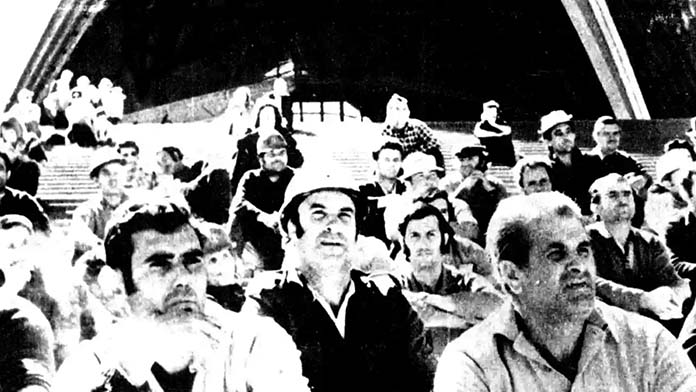The construction of the Sydney Opera House, opened 50 years ago this month, saw unionists launch an experiment with workers’ control of production, writes Erima Dall
Built on Bennelong Point, at a site known as Tubowgule, the iconic Sydney Opera House is now 50 years old. The official website tells us that this “masterpiece of human creative genius exists because a few brave people dared to think differently”.
Those mentioned include the Danish architect Jørn Utzon and NSW Premier Joseph Cahill, who cost taxpayers millions by rushing the project before a way to hold the roof up was finalised, determined as he was to secure his place in the history books.
But some of the brave people who dared to think differently are hidden from the official history. These are the workers—the fitters, riggers, and builders’ labourers—who took over construction of the Opera House 51 years ago and ran it themselves in a tactic known as a “work-in”.
In the process these workers, members of the Builders Labourers Federation (BLF) and the Amalgamated Metal Workers Union (AMWU), won 48 hours pay for a regular 35-hour week, as well as the right to elect their foremen, big redundancy payments and four weeks’ annual leave with a 25 per cent loading. The wages won were among the highest in Australia in 1972.
These workers gave us a glimpse of how production can be self-governed under workers’ control.
Setting the stage
Construction of the Opera House started in 1959. It took 13 years to complete.
It was through 1971 that things heated up—with constant low-level disputes over building the rotating stages in the Opera and Drama theatres.
McNamee Industries was the company with the contract to build the stages. By 1972 they had changed their managerial staff three times. Three foremen were forced out by the union.
McNamee regularly stopped work to manage small budgetary decisions. Progress was painfully slow and micromanaged. Two to three strikes per day were not uncommon to deal with disputes and then recover lost wages.
While the unionised workers mostly won, frustration was growing.
According to union leaders Joe Owens and John Wallace from the BLF and AMWU, “A new engineer arrived [in 1972] who arrogantly told the workers ‘give me a fair go and you will get one’. This was interpreted as: Do as I tell you and you will get a lolly. As a gesture of good faith, the lolly was asked for first by the workers, and the indignant refusal made it clear that another hard year was in the making.”
A key issue was wages. The company had priced the contract in 1969, prior to a surge in inflation. The workforce resolved to demand a 35-hour week for 48 hours pay, threatening to dismantle the revolving stage if their demand was not met.
The work-ins
The first work-in began when a fitter was sacked for jokingly throwing water over his mate. This happened while the builders’ labourers were on strike. The fitters were reluctant to walk out since they were being paid to do very little while the dispute outside remained unresolved.
The idea of a work-in drew astonishment and laughter when it was first proposed in a workers’ meeting. But, to everyone’s surprise, after some debate the suggestion won the vote.
The plan was to bring the sacked worker back in without management approval. For three days he was smuggled on and off the job—often in hiding but turning up for meal breaks and participating in meetings.
This was the first time the tactic was used and it ended in success! The sacked worker was not only reinstated but paid for the days of his work-in.
A few weeks later a further dispute began over wage inequality between fitters and riggers. A black ban was put on any work done by the fitters—this dragged work to a halt.
In retaliation the company cancelled work for Saturday. Outraged, the workforce resolved to go in anyway, beginning the first mass work-in.
They walked onto the site past the supervisors and once inside they elected their own foremen and safety officers. They then broke into the Opera Theatre toolbox with a crowbar to obtain tools.
Safety was a high priority, as everyone doubted workers’ compensation would cover them. Confused supervisors watched on with interest and indignation.
Day one reportedly “ended with a feeling of tremendous achievement, the last half an hour was taken up by a meeting and the day’s events reviewed”.
The engineers were told not to co-operate with the workers. But rather than have workers stand around doing nothing (which would be bad for morale and discipline) it was resolved that if work ran out they would dismantle what they’d built and start again.
By the second day company foremen were completely ignored and told to stay out of the way. One tried to sack three employees but this was shrugged off and the workers continued on unbothered. In the end an engineer approached an elected foreman and asked, “Are you the person to speak to if I want a job done?”
By mid-week management, desperate to regain control of the situation, agreed to pay for the work done on Saturday as well as Monday and Tuesday! The workforce was jubilant.
But now the company was out for retaliation. Every day there were new petty attacks—the time cards for Monday and Tuesday had cut hours; the three workers sacked were not let inside and so on.
Each instance was fought until, a week later, McNamee decided the whole fiasco was not worth their time and money. Unable to put up with these insubordinate unionists any longer, they walked from the project. All the workers were handed letters of dismissal.
Since there were so many contractors on the site, the workforce decided to fight for the head engineering company Waagner-Biro to hire them back.
A flurry of activity began. The workers occupied the stage and, later, Waagner-Biro’s offices. Delegations were sent to visit the Public Works Minister, the Governor General and the state Opposition leader. Leaflets were distributed to visitors.
The Ministry and the engineering company both insisted it was the others’ problem to sort things out. But the deadline for the completion of the Opera House was looming, with arrangements being made for the Queen to open it the following year.
Finally on 1 May it was announced that another contractor had been found and negotiations took place. This is when the BLF and AMWU won the 35-hour week for the same pay as 48 hours, the right to elect their own supervisors and four weeks’ annual leave.
Work did not actually start until 16 May because of an electricians’ strike—and all lost days were paid for.
Lessons
The work-in showcased workers’ ability to organise themselves and run production with incredible discipline and motivation.
Ask most workers today if they could run society, and they would probably say no. But ask if they can do a better job than their boss and you will get a very different answer.
The BLF and AMWU, in demanding the 35-hour week, had declared they could achieve the same productivity as in 48 hours. This was in fact achieved, to the astonishment of the managers. How? Reduction in absenteeism and the abolition of demarcation of work roles—with tradesmen helping do traditional labourers’ work and vice versa.
Wallace and Owens say, “It was like being released from prison after years of hard labour. Even the most menial tasks were performed with enthusiasm.”
The commitment to debate, democracy and rank-and-file control was another lesson.
Every day workers would convene at the gates at 7.30am and often revisit decisions made in the previous day’s final meeting. “Meetings were always informal. No strict rules of debate operated … everyone could have a say without feeling overawed by the occasion.”
But there are broader lessons, too. The work-in never evolved beyond a tactic to win back-pay and reforms. It was isolated and did not spread to broader sections of the working class.
This is despite the potential that existed at that time: the work-in tactic was used in many disputes in NSW in the 1970s.
Elsewhere the BLF was posing the possibility of workers’ control in a serious way in Sydney—refusing to knock down low-income housing and saving large swathes of bushland through Green Bans.
British experiments in workers’ control such as in the Upper Clyde and Lucas Aerospace occurred in the same decade. And 1968 had seen ten million workers occupy their workplaces in France in a massive general strike.
Then, in 1973, workers’ control erupted in Chile on a mass scale, with the establishment of workers’ councils known as Cordones.
These developments were not a coincidence—they show that workers’ power is an organic response to capitalist exploitation, which is organised according to private ownership and profit.
There were some attempts to generalise the experience in Sydney in the 1970s, with a “Workers Control Conference” in Easter 1973—but workers’ control was treated mostly as a union tactic and not a road to workers’ control of society as a whole.
Despite these limitations, the legacy of this one, short month 51 years ago lives on in the conditions won, in the Opera House itself, and in the evidence that workers’ control is possible.
Workers built this city. Their story should be widely celebrated but it will be up to unionists, activists and socialists to keep it in the spotlight and to prepare for the encore.






